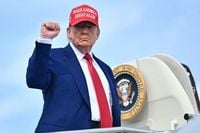On June 21, 2025, the United States launched a significant military strike against Iran's nuclear program, marking a historic and highly controversial moment in international relations. President Donald Trump announced from the White House that three of Iran's underground nuclear facilities—Fordow, Natanz, and Isfahan—were targeted and successfully attacked. This marked the first direct U.S. military action against major Iranian sites on Iranian soil since the 1979 Iranian Revolution, an act widely regarded as tantamount to a declaration of war.
The operation involved the deployment of advanced military technology, including six B-2 Spirit stealth bombers from Whiteman Air Force Base in Missouri, each capable of carrying the massive GBU-57 bunker buster bombs. According to multiple reports, twelve of these latest-generation bunker busters were dropped on the Fordow facility alone. Fordow is a deeply buried nuclear site located in mountainous terrain and is considered the heart of Iran's nuclear program, producing most of its highly enriched uranium since 2021. The GBU-57 is uniquely capable of penetrating more than 60 meters underground, targeting such fortified facilities without requiring a ground invasion.
Additional attacks involved the launch of 30 Tomahawk cruise missiles from a U.S. Ohio-class submarine, striking the Natanz and Isfahan sites. Natanz is Iran's oldest and largest uranium enrichment facility, previously damaged by Israeli airstrikes and cyberattacks during the Bush and Obama administrations. Isfahan houses critical facilities for converting uranium into weapons-grade material, with underground storage reportedly containing enough highly enriched uranium for approximately ten nuclear weapons. However, it remains unclear if the recent strikes destroyed these stockpiles.
President Trump took to social media to share updates throughout the day, declaring, "We have successfully completed attacks on 3 Iranian nuclear facilities, Fordow, Natanz, and Isfahan. All bombs were dropped on the main nuclear facility, Fordow." He saluted the American military, stating, "I salute our great American soldiers. No army in the world can do such a thing." In a separate post, he emphatically declared, "FORDOW IS GONE," underscoring the extent of the damage inflicted.
Later that evening, at 10 PM local time, Trump delivered a public address from the White House accompanied by Vice President J.D. Vance, Secretary of State Marco Rubio, and Secretary of Defense Pete Hegseth. He warned Iran that peace must now be pursued, stating, "Iran will have peace or tragedy, and that tragedy will be far greater than what we have witnessed over the past eight days." He cautioned that many targets remain and threatened that future attacks would be "much stronger and much easier" if Iran failed to comply.
Trump framed the operation as a decisive step to dismantle Iran's nuclear enrichment capabilities and to halt what he described as the world's largest state sponsor of terrorism from posing a nuclear threat. "The strike was a military success," he asserted, "Iran's major nuclear enrichment facilities have been completely and totally eliminated." Reflecting on decades of hostility, he noted, "For 40 years, Iran has said 'Death to America, death to Israel.' We have lost thousands of lives as a direct result of Iranian hatred, and hundreds of thousands have died across the Middle East and the world." He pledged to end this cycle of violence, emphasizing that it "will not continue." Trump also expressed gratitude to Israeli Prime Minister Benjamin Netanyahu, highlighting the unprecedented cooperation between the two nations in executing the operation.
The U.S. military operation was meticulously planned, with B-2 bombers reportedly taking off with partial fuel loads due to the heavy weight of the bunker buster bombs, necessitating aerial refueling during their trans-Pacific flight. The Wall Street Journal reported that Israel played a critical role in neutralizing Iran's air defenses through hundreds of airstrikes and intelligence operations, effectively clearing the way for the U.S. to conduct its strikes.
Domestically, the response to the strikes was sharply divided. Republican congressional leaders, including House Speaker Mike Johnson and Senate Majority Whip Jon Thune, strongly endorsed the President's actions, praising the preemptive move to prevent Iran from acquiring nuclear weapons. Senate Armed Services Committee Chairman Roger Wicker called it an appropriate decision to eliminate an existential threat, and Senate Foreign Relations Committee Chairman Jim Risch described the strikes as precise and limited, emphasizing there would be no deployment of ground troops.
Conversely, some lawmakers criticized the military action for bypassing Congress. Republican Representative Thomas Massie and Democratic Representative Ro Khanna demanded a congressional vote under the War Powers Act, while Representative Marjorie Taylor Greene opposed the strikes outright, stating, "This is not our fight." The debate underscored ongoing tensions over executive authority in matters of war.
Internationally, United Nations Secretary-General António Guterres expressed grave concern, calling the U.S. attack a "dangerous escalation in an already volatile region" and a "direct threat to international peace and security." He warned that the conflict risked spiraling out of control, with potentially catastrophic consequences for civilians, the region, and the world at large.
In anticipation of potential retaliatory attacks, the U.S. State Department began operating evacuation flights for American citizens and permanent residents in Israel, with two flights departing from Tel Aviv to Athens on June 21. Iran had previously threatened to target U.S. forces stationed across the Middle East if the U.S. intervened in the conflict. Ray Takeyh, a senior fellow at the Council on Foreign Relations, told The New York Times, "They have been humiliated in every possible way and will seek to restore their pride by any means necessary." The New York Times characterized the strikes as an act of war, a step that several U.S. presidents since Jimmy Carter had sought to avoid.
This military action represents a pivotal moment in U.S.-Iran relations and Middle East geopolitics. It challenges the delicate balance of power and raises urgent questions about the potential for broader conflict in a region already fraught with tension. As the world watches, the coming days will reveal whether this bold move leads to lasting peace or ignites a wider and more devastating war.





